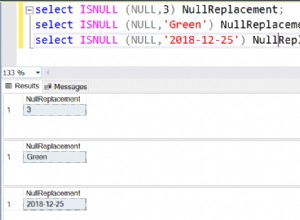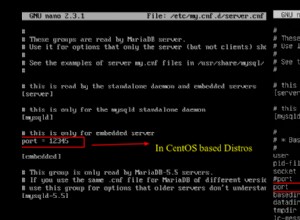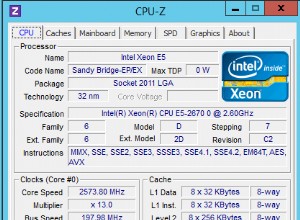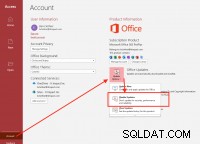Eine Option:Pushen Sie die Logik, um zu prüfen, ob eine Spalte verfolgt wird, in die f_log-Prozedur und übergeben Sie dann alle Spalten.
Wenn Ihre track_Table beispielsweise (table_name, column_name, allow)-Werte für jede Spalte enthält, die Sie verfolgen möchten, dann etwa so
CREATE OF REPLACE PROCEDURE f_log( p_id varchar2
,p_table_name varchar2
,p_column_name varchar2
,p_old_val varchar2
,p_new_val varchar2)
as
l_exists number;
cursor chk_column_track IS
SELECT 1
FROM track_TABLE
WHERE upper(TABLE_NAME) = upper(p_table_name)
AND UPPER(column_name) = upper(p_column_name)
AND upper(allow) = 'Y';
begin
open chk_column_track;
fetch chk_column_track into l_exists;
if chk_column_track%found then
--do the insert here
end if;
close chk_column_track;
end;
/
CREATE OR REPLACE TRIGGER trg_TRACK
AFTER INSERT OR UPDATE OR DELETE ON ABC
FOR EACH ROW
DECLARE
n_id varchar(50);
BEGIN
n_id := NVL(:old.id, :new.id);
-- send all of the values to f_log and have it decide whether to save them
f_log(:old.id,'COL1',:old.col1,:new.col1);
f_log(:old.id,'COL2',:old.col2,:new.col2);
f_log(:old.id,'COL3',:old.col3,:new.col3);
...
END;
Und um Himmels willen, schreiben Sie die Werte in Ihrer track_table beim Einfügen in Großbuchstaben, damit Sie die gespeicherten Werte nicht UPPER() machen müssen, wodurch jeder Index für diese Werte nutzlos wird!
Nun, dies wird einige Ressourcen verbrauchen, um jeden Spaltennamen bei jeder Operation zu überprüfen, aber wenn Sie keine hohen Volumen ausführen, ist dies möglicherweise überschaubar.
Andernfalls benötigen Sie eine elegantere Lösung. Wie die Nutzung der Leistungsfähigkeit von Sammlungen und der TABLE()-Klausel, um die track_table-Suche in einer Massenoperation durchzuführen. Denken Sie daran, dass ich im Moment nicht in meiner Datenbank bin, also habe ich diesen Code nicht testweise kompiliert.
CREATE OR REPLACE TYPE t_audit_row AS OBJECT (
p_table_name varchar2(30)
,p_column_name varchar2(30)
,p_id varchar2(50)
,p_old_val varchar2(2000)
,p_new_val varchar2(2000)
);
CREATE OR REPLACE TYPE t_audit_row_table AS TABLE OF t_audit_row;
CREATE OR REPLACE PROCEDURE f_log (p_audit_row_table t_audit_Row_table)
AS
begin
-- see how we can match the contents of the collection to the values
-- in the table all in one query. the insert is just my way of showing
-- how this can be done in one bulk operation. Alternately you could make
-- the select a cursor and loop through the rows to process them individually.
insert into my_audit_log (table_name, column_name, id, old_val, new_val)
select p_table_name
,p_column_name
,p_id
,p_old_val
,p_new_val
FROM track_TABLE TT
,table(p_audit_row_table) art
WHERE tt.TABLE_NAME = art.p_table_name
AND tt.column_name = art.p_column_name
AND tt.allow = 'Y';
end;
/
CREATE OR REPLACE TRIGGER trg_TRACK
AFTER INSERT OR UPDATE OR DELETE ON ABC
FOR EACH ROW
DECLARE
l_id varchar(50);
l_audit_table t_audit_row_table;
BEGIN
l_id := NVL(:old.id, :new.id);
-- send all of the values to f_log and have it decide whether to save them
l_audit_table := t_audit_row_table (
t_audit_row ('ABC','COL1',l_id, :old.col1, :new.col1)
,t_audit_row ('ABC','COL2',l_id, :old.col2, :new.col2)
,t_audit_row ('ABC','COL3',l_id, :old.col3, :new.col3)
,...
,t_audit_row ('ABC','COLn',l_id, :old.coln, :new.coln)
);
f_log(l_audit_table);
end;
/




